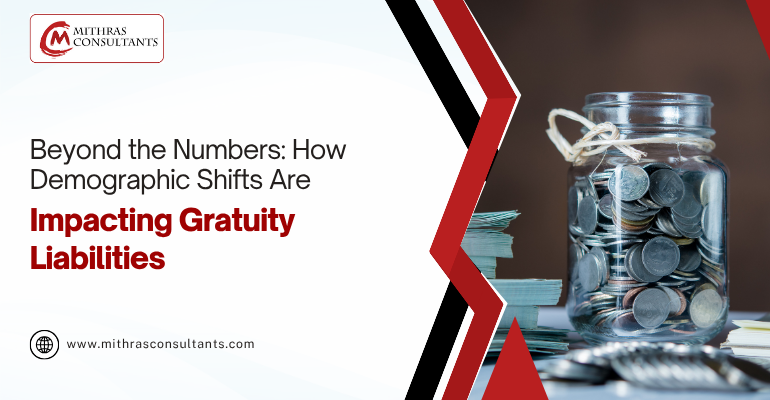Beyond the Numbers: How Demographic Shifts Are Impacting Gratuity Liabilities

Not all numbers tell the full story. In boardrooms and balance sheets across India, gratuity liabilities are often viewed as static, just another line item, another provision. But the reality? They are anything but fixed. As the demographic composition of the workforce changes, these liabilities are quietly evolving beneath the surface, shifting with every promotion, every birthday, and every new hire.
Gratuity is no longer a passive cost. It’s a living, moving obligation shaped deeply by workforce demographics. And unless companies begin to understand the subtle dynamics at play, they risk being blindsided, not just financially, but in strategic workforce planning.
This is the evolving lens through which leading firms like Mithras Consultants help businesses approach their gratuity valuation, not as a regulatory afterthought, but as a proactive financial strategy grounded in demographic insight.
Let’s unpack how demographic changes are reshaping the way organisations manage their actuarial valuation obligations.
The Age Equation: Why Millennials & Gen Z Matter More Than You Think
A younger workforce might look like a cost-saving dream. After all, fewer years of service means lower gratuity payouts, right?
Not always.
While it’s true that younger employees reduce immediate end of service benefits, they also introduce volatility. Higher attrition, frequent job-hopping, and evolving benefit expectations make it harder to project future liabilities with certainty. And in contrast, an ageing workforce may mean larger liabilities but more stable, predictable models, if calculated properly.
This is where a professionally executed actuarial valuation becomes essential. It’s not about guessing liabilities; it’s about calculating them with mathematical precision, incorporating age distribution, mortality rates, attrition patterns, and salary progression.
Mithras Consultants leverages actuarial intelligence to decode these complexities and ensure gratuity obligations are accurately forecasted, compliant, and strategically insightful.
Changing Tenure Trends: The Death of the 20-Year Career
Gone are the days when employees stayed with one company from graduation to retirement. Today, a 5-year stint is considered long-term. This shift has a dramatic impact on gratuity valuation. Since gratuity eligibility kicks in after five years of continuous service, a significant portion of employees may never even qualify.
While that might seem like a financial relief, it creates planning blind spots. What happens if your top talent stays longer than expected? Or if your retention strategy works too well?
Without dynamic projections that factor in real-world tenure trends, your liability estimates may be dangerously under- or over-reported. Companies across India are now turning to Mithras Consultants to incorporate real-world attrition probabilities into their end of service benefits calculations, ensuring that liabilities evolve as their workforce does.
Gender Diversity & Policy Impacts
As more women enter leadership and long-tenure roles, gratuity liabilities are also influenced by maternity benefits, career breaks, and rehiring policies. This changing gender balance impacts everything, from salary progression models to withdrawal rates.
The best actuarial valuation professionals understand this. It’s not just about formulas; it’s about people, policy, and probability. Mithras Consultants, with their nuanced approach, account for such demographic details, ensuring no hidden liability goes unnoticed.
The Inflation & Urbanisation Effect
Demographics aren’t just about age and tenure. They’re also about geography, education, and industry shifts. Urban workforces demand higher wages. Tech professionals receive steeper salary escalations. Inflation affects replacement costs and salary projections, all of which feed into your gratuity valuation models.
An actuarial report that doesn’t consider these shifts is more guesswork than guidance.
The Strategic Opportunity Most CFOs Are Missing
Here’s the part most finance leaders don’t talk about: a well-informed gratuity valuation is not just a compliance requirement. It’s a strategic tool.
Done right, it can help companies:
- Forecast HR costs more accurately.
- Plan funding strategies with greater control.
- Align employee benefit plans with business goals.
- Pre-empt policy risks linked to upcoming regulatory changes.
End of service benefits are growing in importance as workforce models become more flexible and global. As startups mature and legacy companies evolve, smart CFOs are partnering with specialised consultants like Mithras Consultants, not just to tick a regulatory box, but to build future-proof workforce strategies.
Conclusion: Reimagining Gratuity Through a Human Lens
It’s time to stop looking at gratuity liabilities as static, backward-looking provisions. They are dynamic, deeply human financial obligations shaped by every shift in the demographic makeup of your team.
Whether you’re preparing for a merger, adopting remote-first models, or just rethinking your benefits policy, your actuarial valuation should reflect your people, today and tomorrow.
Partnering with Mithras Consultants allows businesses to see beyond the numbers. Their expertise in gratuity valuation and end of service benefits isn’t just technical, it’s strategic, adaptive, and deeply informed by real-world workforce shifts.

 Call Us
Call Us Whatsapp Us
Whatsapp Us